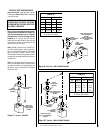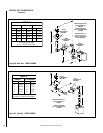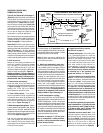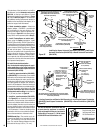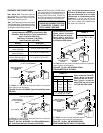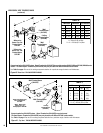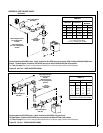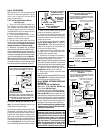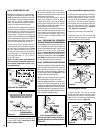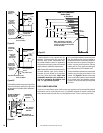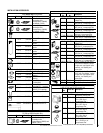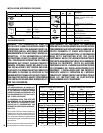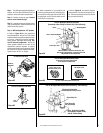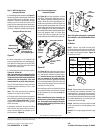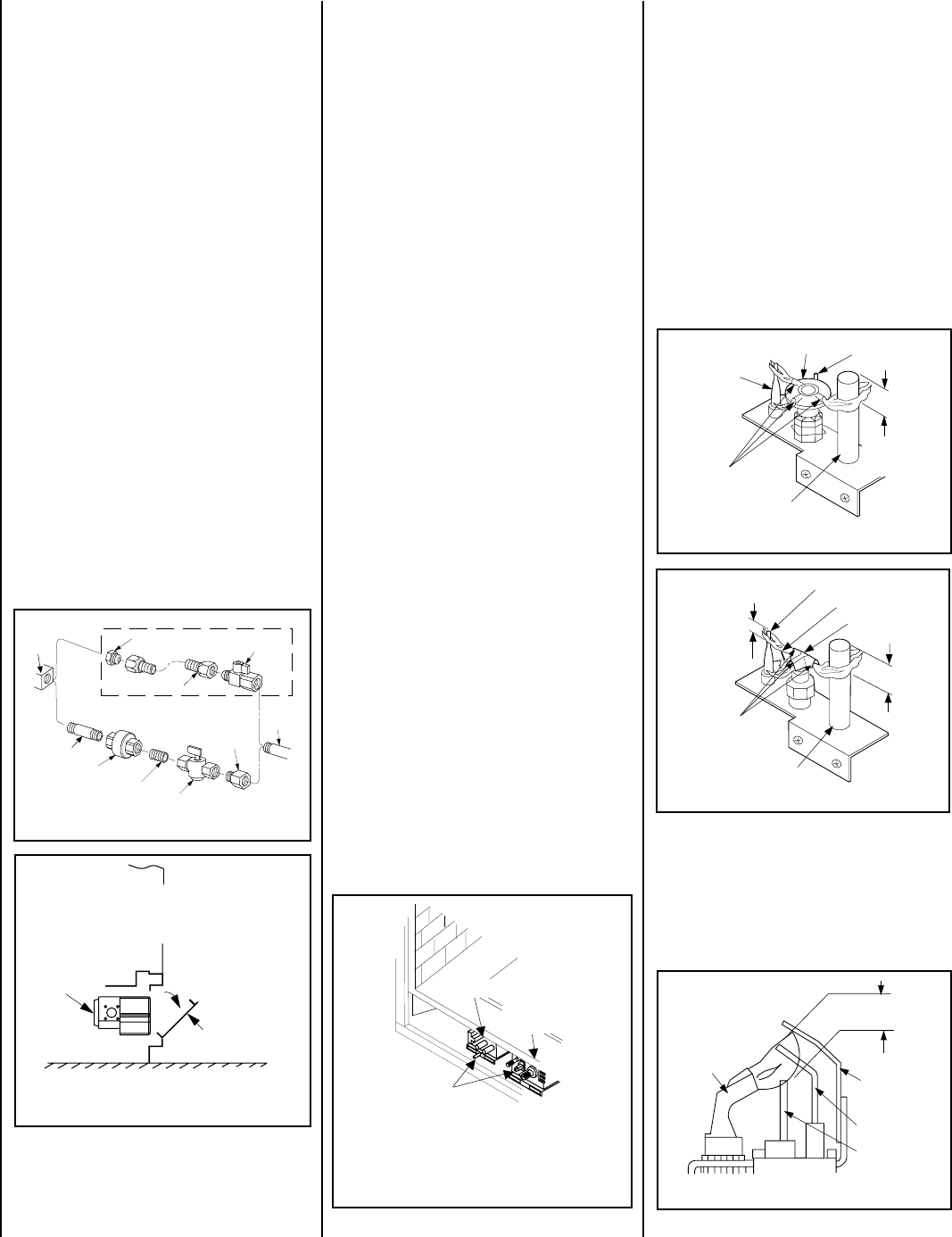
22
NOTE: DIAGRAMS & ILLUSTRATIONS NOT TO SCALE.
Secure all joints tightly using appropriate
tools and sealing compounds (ensure pro-
pane resistant compounds are used in pro-
pane applications).
The gas control valve is located in the lower
control compartment. To access the valve open
the lower control compartment door
(Figure
51)
. The millivolt control valve has a ³⁄₈"
(10 mm) NPT thread inlet port. The electronic
control valve has a ¹⁄₂" (13 mm) NPT thread inlet
port and is fitted with a ¹⁄₂" x ³⁄₈" (13 mm x
10 mm) NPT fitting.
Make gas line connections. All codes require a
shut-off valve mounted in the supply line.
Fig-
ure 50
illustrates two methods for connecting
the gas supply. The flex-line method is accept-
able in the U.S., however, Canadian require-
ments vary depending on locality. Installation
must be in compliance with local codes.
These appliances are equipped with a gas flex
line for use (where permitted) in connecting the
unit to the gas line. A gas flex line is provided
to aid in attaching the direct vent appliance to
the gas supply. The gas flex line can only be
used where local codes permit. See
Figure 50
for flex line description. The flex line is rated for
both natural and propane gas. A manual shut
off valve is also provided with the flex line.
Step 6. CONNECTING GAS LINE
Gas
Stub
¹₂" x
³₈" Flare
Shut-Off Valve
³₈" Flex Tubing
³₈" NPT x ³₈
Flare Fitting
³₈" Nipple
³₈"
Union
³₈" Close Nipple
³₈" Shut-Off Valve
¹₂
x ³₈ "
Reducer
Gas
Valve
Gas Flex Line Connector
Control
Valve
Lower Control
Compartment
Door
Open the lower panel or louver assembly by
gently depressing the outer top corners of the
panel until the catches “pop” the panel free,
allowing it to swing out and down to open.
ELECTRONIC
Proper Flame
Adjustment
Pilot
Nozzle
3/8 To 1/2 Inch
(9 mm to 13 mm)
Ground
Electrode
Flame Rod
Hot Surface
Igniter
Figure 51
Figure 50-
GAS CONNECTION
Figure 55
Figure 52
Sit and Honeywell Millivolt Gas Valve
Showing Piezo Ignitor Location (Each Unit is
Equipped with Only One of these Gas Valves)
Piezo
Ignitor
SIT Gas Valve
Honeywell
Gas Valve
Step 8. CHECKING APPLIANCE OPERATION
With gas line installed run initial system checkout
before closing up the front of the unit. Follow the
pilot lighting instructions provided in the
Homeowner's Care and Operation Instructions.
For piezo ignitor location see
Figure 52
(SIT and
Honeywell millivolt appliances only).
Note: Instructions are also found on the litera-
ture tag attached to the gas valve train.
When first lighting the appliance, it will take a few
minutes for the line to purge itself of air. Once
purging is complete, the pilot and burner will light
and operate as indicated in the instruction manual.
Subsequent lightings of the appliance will not re-
quire such purging. Inspect the pilot flame (remove
logs, if necessary, handling carefully).
Step 7. INSTALLING LOGS, DECORATIVE
VOLCANIC STONE AND GLOWING EMBERS
Turn on gas supply and test for gas leaks using
a soapy water solution. Never use an open
flame to check for leaks.
Electronic Appliance Checkout
To light the burner, turn ‘ON’ the optional
remote wall switch and turn the gas control
switch to the “ON” position. Ensure the ignitor
lights the pilot. The pilot flame should engulf
the flame rod as shown in
Figure 55
.
OPENING CONTROL
COMPARTMENT DOOR
The packaged logs are located within the fire-
box. The decorative volcanic stone and glowing
embers are packaged separately in plastic bags
located in the control area of the fireplace.
Refer to the Homeowner's Care and Operation
Guide for detailed placement instructions for
decorative volcanic stone, and to the Log Place-
ment Guide for detailed placement instructions
for logs and glowing embers (rockwool).
SIT and Honeywell Millivolt Appliance Checkout
The pilot flame should be steady, not lifting or
floating. Flame should be blue in color with
traces of orange at the outer edge. The top ³⁄₈"
(10 mm) at the pilot generator (thermopile)
and the top ¹⁄₈" min (tip) of the quick drop out
thermocouple should be engulfed in the pilot
flame. The flame should project 1" (25 mm)
beyond the hood at all three ports (
Figure 53
- SIT, Figure 54 - Honeywell
)
Replace logs if removed for pilot inspection.
To light the burner; turn “ON” the remote wall
switch and rotate the gas valve control knob
counterclockwise to the “ON” position.
Figure 53
Figure 54
A. Mix a 50% dish soap, 50% water solution.
B. Light the appliance (refer to the lighting
instructions provided in the Homeowner's Care
and Operation Instructions).
C. Brush all joints and connections with the
soapy water solution to check for leaks. If
bubbles are formed, or gas odor is detected,
turn the gas control knob to the “OFF” position.
Either tighten or refasten the leaking connec-
tion and retest as described above.
D. When the gas lines are tested and leak free,
observe the individual tongues of flame on the
burner. Make sure all ports are open and pro-
ducing flame evenly across the burner. If any
ports are blocked, or partially blocked, clean
out the ports.
MILLIVOLT
Thermocouple
Hood Ignitor Rod
³⁄₈" Min
(9 mm)
Thermopile
Pilot
Nozzels
¹⁄₈" Min
(3 mm)
Thermocouple
Ignitor Rod
Hood
³⁄₈" Min
(9 mm)
Thermopile
MILLIVOLT HONEYWELL
Pilot
Nozzels



